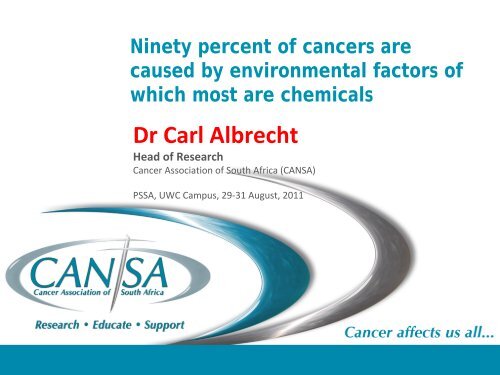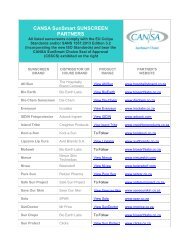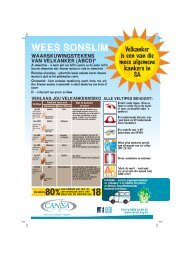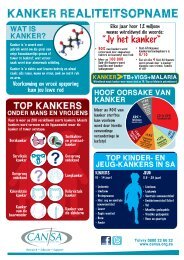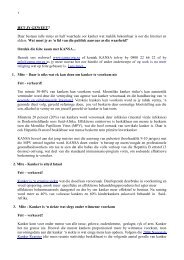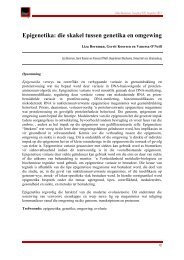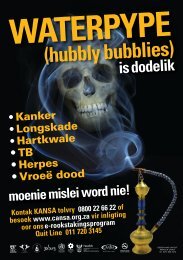Dr Carl Albrecht - The Cancer Association of South Africa
Dr Carl Albrecht - The Cancer Association of South Africa
Dr Carl Albrecht - The Cancer Association of South Africa
You also want an ePaper? Increase the reach of your titles
YUMPU automatically turns print PDFs into web optimized ePapers that Google loves.
Ninety percent <strong>of</strong> cancers are<br />
caused by environmental factors <strong>of</strong><br />
which most are chemicals<br />
<strong>Dr</strong> <strong>Carl</strong> <strong>Albrecht</strong><br />
Head <strong>of</strong> Research<br />
<strong>Cancer</strong> <strong>Association</strong> <strong>of</strong> <strong>South</strong> <strong>Africa</strong> (CANSA)<br />
PSSA, UWC Campus, 29‐31 August, 2011
Basic <strong>Cancer</strong> Facts<br />
• This year, more than 1 million Americans and<br />
more than 10 million people worldwide are<br />
expected to be diagnosed with cancer.<br />
• <strong>Cancer</strong> kills more people worldwide than<br />
AIDS, malaria and TB combined.<br />
• Only about 10% <strong>of</strong> all cancer cases can be<br />
attributed to genetic defects, whereas the<br />
remaining 90% have their roots in the<br />
environment and lifestyle.
<strong>The</strong>re are two wars against<br />
cancer<br />
We have chosen to focus on prevention
We believe that prevention<br />
is the cure for cancer<br />
• This is good news because if the environmental<br />
factors and lifestyles causing cancer can be<br />
controlled, cancer will disappear.<br />
• Vision –looking ahead:<br />
• All carcinogens will be known by 2020.<br />
• All carcinogens will be controlled by 2100.<br />
• By the end <strong>of</strong> the current century cancer should be<br />
relegated to a minor health problem.
Implications <strong>of</strong> a global<br />
control <strong>of</strong> carcinogens<br />
• 1. No more cancer<br />
• 2. Less chronic diseases<br />
• 3. Greater integrity <strong>of</strong> genome<br />
• 4. Healthier planet
<strong>Cancer</strong>s are caused by carcinogens<br />
Epicarcinogenesis<br />
Carcinogens attack DNA
Different kinds <strong>of</strong> carcinogens<br />
• 1. Chemicals –60%<br />
• 2. Viruses<br />
• 3. Bacteria<br />
• 4. UV light<br />
• 5. Gamma radiation<br />
• 6. Cell phone EMR ?
What are the carcinogens?
Table 4: Proportions <strong>of</strong> cancer deaths attributed to<br />
various different factors<br />
Percent <strong>of</strong> all cancer<br />
deaths<br />
Factor Best<br />
estimate<br />
Range<br />
1 Tobacco 30 25-40<br />
2 Alcohol 3 2-4<br />
3 Diet 35 10-70<br />
4 Food additives
What role do chemicals play<br />
in carcinogenesis?<br />
• 1. Cigarette smoke<br />
• 2. Ethanol<br />
• 3. Natural carcinogens<br />
• 4. Man‐made carcinogens<br />
• 5. Infections (HBV, HPV, HIV)<br />
• 6. UV light<br />
• 7. Obesity<br />
• 8. Genetic predisposition<br />
30%<br />
10%<br />
10%<br />
10%<br />
60%<br />
15%<br />
5%<br />
10%<br />
10%<br />
100%
Current Wisdom<br />
• Most <strong>of</strong> cancers are due<br />
to wrong life‐style<br />
choices:<br />
• Wrong diet<br />
• Smoking<br />
• Lack <strong>of</strong> exercise<br />
• It is your fault<br />
11
New Wisdom<br />
• Most <strong>of</strong> cancers are due<br />
to wrong life‐style<br />
choices and exposure to<br />
man‐made carcinogens:<br />
• Wrong diet<br />
• Smoking<br />
• Lack <strong>of</strong> exercise<br />
• Exposure to natural<br />
and man‐made<br />
carcinogens and co‐<br />
carcinogens<br />
• It is your fault<br />
and it is also<br />
industry’s fault<br />
12
Controlling environmental<br />
carcinogens
Hepatitis B and liver cancer
Hepatitis B virus<br />
Legislation and carcinogens<br />
• Vaccination <strong>of</strong> all babies against<br />
hepatitis B virus thus preventing<br />
hepatocellular carcinoma.
Smoking and lung cancer
Legislation against smoking<br />
and tobacco.<br />
Benzopyrene<br />
Percentage smokers<br />
Minus 27%
Trans fats and food
Legislation against trans fats<br />
passed 17 August 2011
Omega-6 vs Omega-3 fatty acids
Chemical analysis <strong>of</strong> <strong>South</strong><br />
<strong>Africa</strong>n margarines
RESULTS TRANS-FATS.<br />
• All forty margarine products had trans‐fat<br />
concentrations (grams/100 grams<br />
margarine) <strong>of</strong> less than 2 percent.<br />
•This is within the boundary set by the<br />
Department <strong>of</strong> Health in the Government<br />
Gazette <strong>of</strong> 30 March 2010 where it states<br />
that the trans‐fat content should not exceed<br />
2 grams per 100 grams <strong>of</strong> product foodstuff<br />
as consumed.<br />
•<strong>The</strong> results and the pending legislation is<br />
good news and hopefully trans‐fats will<br />
cease to be a problem in <strong>South</strong> <strong>Africa</strong>.
RESULTS: Ratio <strong>of</strong> omega-6 to omega-3 fatty acids<br />
• <strong>The</strong> omega‐6/omega‐3 ratio differs widely<br />
(up to 20‐fold) when the different<br />
margarines were compared. <strong>The</strong> lowest was<br />
2.21 and the highest was 44.30.<br />
•<strong>The</strong>re is growing consensus that this ratio<br />
should be low, in the order <strong>of</strong> 2 to 1 , to be<br />
beneficial and to reduce the risk <strong>of</strong> cancer<br />
by counteracting inflammation.<br />
•Analysis <strong>of</strong> the data showed that there<br />
were two margarine products with ratios <strong>of</strong><br />
2.21 and 2.31 (see red arrows).<br />
•<strong>The</strong>se two products were Blossom Canola<br />
Margarine and Blossom Canola Light<br />
Margarine.
Canola Oil
Not all fats are equal.
Ratio <strong>of</strong> n-6 and n-3 fatty<br />
acids is significant<br />
Omega-6/omega-3<br />
= 3/1 or less<br />
Omega-/omega-3<br />
= 5/1 or more<br />
HEALTH<br />
ILLNESS<br />
Too much n-6 could increase the risk<br />
for cancer
Use <strong>of</strong> different oils over time<br />
N-6/n-3= 6.8/1
Fortified maize meal
Legislation to fortify maize<br />
meal<br />
Vit A<br />
Thiamin<br />
Rib<strong>of</strong>lavin<br />
Nicotinamide<br />
Pyridoxine<br />
Folic acid<br />
Iron<br />
Zinc
Colon cancer in <strong>South</strong><br />
<strong>Africa</strong>n females
BPA-Bisphenol A in baby bottles
PC<br />
Example <strong>of</strong> preventing cancer<br />
by removing source from the<br />
market<br />
BPA-Baby bottles banned<br />
in Canada, Denmark,<br />
France,EU, China,
Effect <strong>of</strong> a low dose <strong>of</strong> BPA on<br />
breast tissue<br />
Control milk duct in mouse breast<br />
tissue<br />
Mice treated with 25 ng BPA/kg body<br />
weight per day<br />
25 ng is 1000-times lower than the FDA safety<br />
limit <strong>of</strong> 25 ug it is a trillionth <strong>of</strong> a kg.
BPA has been found in the unborn fetus<br />
Is it involved in breast cancer?
Current Worldwide Breast<br />
<strong>Cancer</strong> Incidence Rate
Animal fat = carcinogen trap
Carcinogens could be hiding in<br />
animal fat like a Trojan Horse<br />
• It is not so smart being at the top <strong>of</strong> the food chain.<br />
• <strong>The</strong> general population is exposed to low levels <strong>of</strong><br />
polychlorinated dibenzo‐p‐dioxins and dibenz<strong>of</strong>urans primarily<br />
through ingestion <strong>of</strong> high‐fat foods such as dairy products, eggs,<br />
and animal fats, and some fish and wildlife. Dioxin‐like chemicals<br />
are measurable in U.S. meats and poultry as a result <strong>of</strong> the<br />
accumulation <strong>of</strong> these substances in the food chain.
Possible factors involved in breast<br />
cancer<br />
• 1. Animal fat<br />
• 2. Animal fat + carcinogen<br />
• 3. Bisphenol A<br />
• 4. Omega‐6/omega‐3 ratio<br />
• 5. Exposure in utero and early life<br />
• 6. Estrogen metabolism
Aflatoxin
Legislation <strong>of</strong> mycotoxin<br />
tolerances 1990<br />
• AFLATOXIN<br />
2001 –”Poison in Peanuts”<br />
Eastern Cape<br />
Peanut butter<br />
4.8 million school children<br />
165 ug per kg Aflatoxin B1<br />
Quality control by DOH
Diethylhexyl adipate<br />
Acrylamide
Putative carcinogens in food<br />
DIETHYLHEXYL ADIPATE<br />
ACRYLAMIDE
Uranium
Controlling uranium in<br />
Potchefstroom drinking water<br />
Values in January 2003 were
CANSA process for prevention<br />
Step 1: Identify “in<br />
your face”<br />
carcinogen or<br />
epicarcinogen<br />
Step 3: Advocate for<br />
government control<br />
and/or endorsement.<br />
Step 2:<br />
Research
Summary<br />
• Chemicals under legislative control:<br />
• 1. Tobacco<br />
• 2. Trans fats<br />
• 3. Aflatoxin<br />
• 4. Maize meal
Summary<br />
• Pending legislative control:<br />
• 5. Bisphenol<br />
A –not in contact with food. Ban.<br />
• 6. Uranium –not in drinking water<br />
• 7. Acrylamide<br />
• 8. Diethylhexyl<br />
–<br />
limits in crisps<br />
adipate<br />
• 9. Hexachlorobenzene<br />
• 10. Polybrominated<br />
• 11. Dioxin –<br />
beef, dairy<br />
–<br />
–<br />
no food contact<br />
alternative for head lice<br />
diphenyl<br />
• 12. Pesticides –in the home<br />
• 13. Formaldehyde –in cosmetics<br />
ethers –in furniture
Endorsed products<br />
• 1. Canola oil<br />
• 2. Canola margarine<br />
• 3. Rooibos<br />
• 4. Weet<br />
Bix<br />
yoghurt<br />
• 5. BPA‐free baby bottles<br />
• 6. Sunscreens
• Prevention is the cure <strong>of</strong> cancer.<br />
Intellectuals solve<br />
problems; geniuses prevent<br />
them.<br />
Albert Einstein
Thank You


